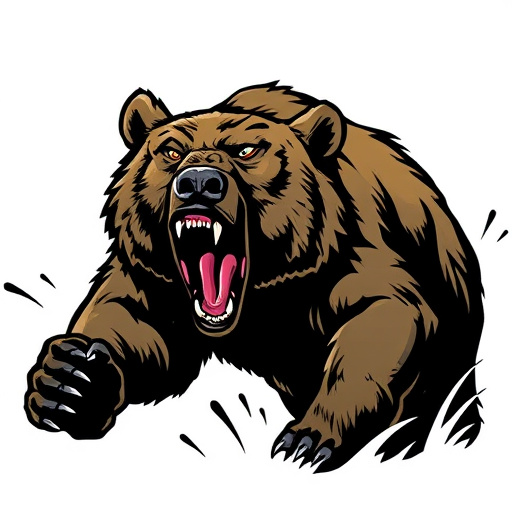Understanding grizzly bear behavior crucial for safety in bear country. Bear pepper spray effective up to 20-30 feet, but its reach limited by distance and weather. Proper application targets eyes and face for maximum disruption. Alternative strategies include noise, gear, travel in groups, and avoiding areas with bear cubs.
In the vast wilderness, encountering a charging grizzly bear is a terrifying prospect. Understanding their behavior and knowing effective defense strategies is crucial for survival. This article explores the power of bear pepper spray as a defensive tool, delving into its efficacy at different ranges and application techniques to maximize its effectiveness. We also uncover alternative strategies beyond pepper spray, providing readers with a comprehensive guide to protecting themselves in grizzly country.
- Understanding Grizzly Bear Behavior and Their Charging Patterns
- The Efficacy of Bear Pepper Spray in Different Scenarios
- Application Techniques: Maximizing Bear Pepper Spray Effectiveness
- Alternative Defense Strategies Beyond Bear Pepper Spray
Understanding Grizzly Bear Behavior and Their Charging Patterns
Understanding grizzly bear behavior is a crucial first step in defending against their charges. These powerful animals are typically solitary and highly territorial, often marking and protecting their hunting grounds. They primarily charge when they perceive a threat to their space or cubs. Recognizing these behaviors can help hikers and campers avoid triggering such aggressive responses.
When a grizzly bear charges, it’s not always an attack; it’s a way of assessing potential danger. Their charging patterns vary; some bears may stop short of actual contact, while others might make direct, powerful runs. Knowing the distance that bear pepper spray is effective—typically around 20-30 feet (6-9 meters)—can be life-saving if used appropriately. This knowledge, combined with understanding bear behavior, enables outdoor enthusiasts to make quick decisions and ensure their safety in bear country.
The Efficacy of Bear Pepper Spray in Different Scenarios
Bear pepper spray is a popular defense option for hikers and outdoor enthusiasts navigating wild territories. Its efficacy, however, varies based on several factors, including proximity, weather conditions, and individual bear behavior. In close-range encounters, where bears charge within 10 feet (3 meters), pepper spray has proven highly effective, temporarily blinding and disorienting the animal. This gives the user crucial seconds to escape or play dead.
At longer distances, say 20-50 feet (6-15 meters), the effect diminishes. Bears can still detect and react to the spray, but their response is often less aggressive. In harsh weather conditions, such as rain or high winds, pepper spray’s reach and potency also decrease, as the particles may disperse before reaching the bear’s eyes. Therefore, users should be aware of these limitations when choosing to rely on bear pepper spray as a primary defense mechanism in different scenarios.
Application Techniques: Maximizing Bear Pepper Spray Effectiveness
To maximize the effectiveness of bear pepper spray, it’s crucial to understand proper application techniques. When facing a charging grizzly, aim for the eyes and face—these areas are highly sensitive, and direct contact can temporarily disable the bear. The recommended range for optimal impact is between 20 and 30 feet (6-9 meters), but in close quarters, even a few feet can be effective.
Bear pepper spray works by irritating the bear’s eyes, nose, and respiratory system, causing tears, coughing, and difficulty breathing. Proper application ensures that these sensitive areas are targeted, enhancing the spray’s potency. Additionally, it’s essential to use the spray in quick, short bursts rather than a prolonged stream, as this can disperse the spray too widely, reducing its concentration at the point of impact.
Alternative Defense Strategies Beyond Bear Pepper Spray
In addition to bear pepper spray, which is effective up to 20 feet (6 meters), there are several alternative defense strategies for navigating wilderness areas prone to grizzly bears. One approach is to make noise while hiking, such as talking or singing loudly, to deter bears from unexpected encounters. Carrying and using a loud whistle can also signal your presence, giving bears time to retreat.
Another tactic is to ensure you have visible gear, like bright clothing or reflective items, which can startle a bear. Additionally, traveling in groups increases safety; bears are less likely to attack a group than an individual. Knowing the behavior patterns of grizzly bears and avoiding areas where cubs are present are also crucial preventive measures.
In understanding grizzly bear behavior and employing effective defense strategies, such as the precise use of bear pepper spray, individuals can significantly enhance their safety in wilderness settings. While no single method guarantees complete protection, combining knowledge of bear charging patterns with alternative defenses like bear pepper spray and other deterrents offers a robust layer of security. Always remember that proper application techniques are crucial for maximizing the effectiveness of bear pepper spray, particularly when faced with these powerful predators. By staying informed and prepared, folks can coexist more harmoniously with grizzlies in their natural habitats.
